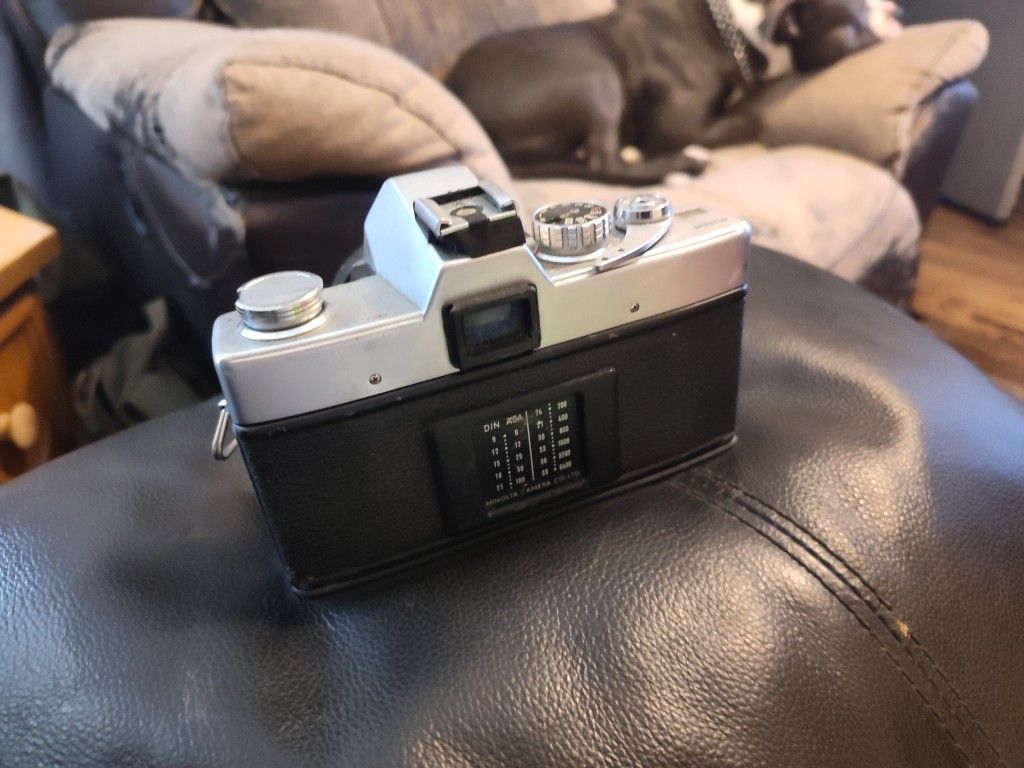Camera
$35
Ships for $4.49
Last updated 2 months ago in Kansas City, MO
Condition: Used (normal wear)
Listed in categories: Electronics & Media - Cameras & Photography - Camera & Camcorder accessories
Chat securely on the app
Sold by
2-Day Purchase Protection
Items shipped through OfferUp come with a 2-day purchase protection.

Additional images
Description
Search Minolta SR-T 101 Article Talk Language Download PDF Watch Edit The Minolta SR-T 101 is a 35mm manual focus SLR camera with Through-The-Lens exposure metering – TTL for short - that was launched in 1966 by Minolta Camera Co. It was aimed at demanding amateur and semi-professional photographers. The SR-T 101 stayed in production for ten years with only minor changes. Minolta SR-T 101 Overview Type 35 mm SLR Lens Lens mount Minolta SR – bayonet (Meter Coupled) Focusing Focus Manual, micro prism with Fresnel lens provided in SLR finder Exposure/metering Exposure TTL meter, manually set aperture and shutter speed (Bulb, 1 to 1/1000 sec) Flash Flash Cold shoe, FP & 1/60 sec X-sync General Dimensions 51 x 86 x 136 mm, 560 g Description edit The design is based on the Minolta SR-7 model V camera of 1962, but the principal design is inherited from the original 1958 Minolta SR-2. The SR-T 101 however, has several significant features apart from the TTL meter. The most significant one is perhaps the full aperture metering facility, allowing the exposure to be set accurately without stopping down. [1] Full aperture TTL metering was commercially first realised in the 1963 Tokyo Kogaku Topcon RE Super. Another unique feature of the SR-T 101 besides the open aperture metering at the time of its release to the public at Photokina in 1966 was the so called "CLC"-metering characteristic. "CLC" stands for "contrast-light-compensation" and was a kind of an early Matrix metering: Two CdS-cells, placed at the front and rear end of the viewfinder prism, provide an overlapping coverage of the center-weighted light-detection area and are electronically coupled together. Therefore the metering system always detects an average of the light travelling through the lens, determined by the contrast division of the metered motive. Landscape photographs with a large area of bright sky and a smaller area of dark ground, for example, are automatically corrected by the contrast-matching "CLC"-metering system. This system works for almost every landscape-format image regardless of the metered contrast range, but requires a much more skilled usage when it comes to portrait-format images. Because of this, Minolta recommended SR-T 101-users to first meter the photographed area and then to swing up the camera for taking the picture to enable the "CLC" an accurate metering.[2] Due to a large pentaprism and double-hinged reflex mirror, the SR-T 101 has an extremely bright viewfinder with a central micro prism focusing aid that in most cases proves to be appropriate, requiring no apparent lines in the motive, since all out of focus objects appear to shimmer. Shutter speed and match needle exposure is visible in the viewfinder, including a battery check index mark showing the required meter needle deflection for a healthy battery when the ON/OFF meter switch on the camera base is set to BC.[3] The SR-T 101 was also available in black. The top cover and the base plate are finished in black enamel while most metal parts are black chromed, but the wind lever is black anodised. The parts still chromed, to name the most obvious ones, include the shutter-release button, the mirror lock-up knob, the depth-of-field preview button and the lens-release button
Take action
Item location map
Map is approximate to keep seller’s location private.
Related searches
- Canon
- Digital camera
- Canon lenses
- Sony camera
- Film camera
- Dslr camera
- Nikon lenses
- Camera lens
- Photo booth props